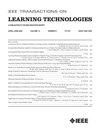用于调查培训的混合现实中的无缝犯罪现场重建:设计与评估研究
IF 2.9
3区 教育学
Q2 COMPUTER SCIENCE, INTERDISCIPLINARY APPLICATIONS
引用次数: 0
摘要
在真实犯罪现场进行调查培训是法医学教育的重要组成部分。然而,将年轻的调查人员带到真实犯罪现场不仅成本高昂,而且面临巨大挑战。混合现实(MR)是最先进的技术之一,为教育领域的实践活动提供了无限可能。本文旨在提出并评估一种使用微软 HoloLens 2.0 的新型 MR 系统设计,该系统可在空间三维扫描和重建的犯罪现场工作。该系统旨在提供一种具有成本效益的体验,帮助科威特年轻警官提高调查技能。通过 44 名年轻警官对系统的可用性、用户交互和性能指标进行了定量评估,并通过一组专家使用畅想协议对系统进行了定性评估。两个小组都对系统的可用性、用户交互和总体满意度给予了肯定,负面反馈极少。基于这些积极反馈,该系统将在未来进入商业化阶段。尽管磁共振设备的成本较高,但专家们表示,该系统是犯罪现场教育和调查实践中必不可少的工具。本文章由计算机程序翻译,如有差异,请以英文原文为准。
Seamless Crime Scene Reconstruction in Mixed Reality for Investigation Training: A Design and Evaluation Study
Investigation training at the real crime scene is a critical component of forensic science education. However, bringing young investigators to real crime scenes is costly and faces significant challenges. Mixed reality (MR) is one of the most evolving technologies that provides unlimited possibilities for practical activities in the education sector. This article aims to propose and evaluate a novel design of an MR system using Microsoft HoloLens 2.0 that is tailored to work in a spatial 3-D-scanned and reconstructed crime scene. The system was designed to be a cost-effective experience that helps young Kuwaiti police officers enhance their investigation skills. The proposed system has been evaluated through system usability, user interaction, and performance metrics quantitatively via 44 young police officers and qualitatively using the think-aloud protocols via a group of experts. Both groups showed positive levels of usability, user interaction, and overall satisfaction, with minimal negative feedback. Based on the positive feedback, the system will be taken into the commercialization stage in the future. Despite the high cost of the MR device, experts stated that the system is needed as an essential tool for crime scene education and investigation practices.
求助全文
通过发布文献求助,成功后即可免费获取论文全文。
去求助
来源期刊

IEEE Transactions on Learning Technologies
COMPUTER SCIENCE, INTERDISCIPLINARY APPLICATIONS-
CiteScore
7.50
自引率
5.40%
发文量
82
审稿时长
>12 weeks
期刊介绍:
The IEEE Transactions on Learning Technologies covers all advances in learning technologies and their applications, including but not limited to the following topics: innovative online learning systems; intelligent tutors; educational games; simulation systems for education and training; collaborative learning tools; learning with mobile devices; wearable devices and interfaces for learning; personalized and adaptive learning systems; tools for formative and summative assessment; tools for learning analytics and educational data mining; ontologies for learning systems; standards and web services that support learning; authoring tools for learning materials; computer support for peer tutoring; learning via computer-mediated inquiry, field, and lab work; social learning techniques; social networks and infrastructures for learning and knowledge sharing; and creation and management of learning objects.
 求助内容:
求助内容: 应助结果提醒方式:
应助结果提醒方式:


